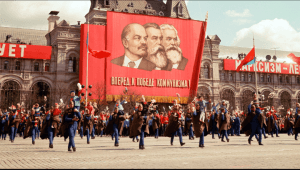The Cold War’s Deepest Wound: How the CIA Engineered the USSR’s Collapse
By Ricky Awodi
“He who sets out on revenge must first dig two graves.” – Chinese Proverb
History is often written by the victors, but some battles are fought in the shadows, their true nature revealed only decades later. One such battle was the Cold War, a silent, strategic confrontation between two global superpowers: the United States and the Soviet Union. While many point to the economic decline of the USSR as the primary reason for its collapse in 1991, a deeper look suggests otherwise. The real cause? A masterstroke by the U.S. Central Intelligence Agency (CIA): the infiltration and political grooming of Mikhail Gorbachev.
The USSR’s Rise and the Cold War’s Genesis
The Union of Soviet Socialist Republics (USSR), spanning much of Eurasia from 1922 to 1991, was forged through annexations and military conquests. After World War I, Russia consolidated its power by absorbing independent states, creating a massive communist bloc. However, it was World War II that truly cemented the USSR’s global influence. The Soviet Red Army’s advance into Eastern Europe led to the subjugation of nations like Poland, Czechoslovakia, and Yugoslavia.
By the late 1940s, with its vast territory and growing military might—especially after acquiring nuclear capabilities—the USSR became the ideological and military counterweight to the capitalist West. What followed was an era of political chess moves, espionage, and global ideological warfare: the Cold War.
The Battle for Global Influence
With nuclear war ruled out due to its catastrophic implications, the Cold War became a battle of intelligence, propaganda, and economic subversion. The CIA and the Soviet KGB were the tip of the spear for both superpowers. Their mission? To destabilize the enemy from within, recruit spies in high places, and control the narrative through global media and education.
For the United States, Africa and the developing world presented an easy target. As former colonies of Western European powers, these nations were already economically and linguistically aligned with the West. The USSR, on the other hand, struggled to penetrate these regions due to language barriers and lack of economic leverage. To counter this, the Soviet Union employed a different tactic: free university education for African students, creating an ideological and intelligence foothold in these nations.

The CIA’s Masterstroke: Planting Gorbachev
The real turning point in the Cold War wasn’t fought on the battlefield but in the corridors of Soviet power. The CIA’s ultimate victory came in the form of Mikhail Gorbachev, a man whose rise to power was carefully orchestrated. Gorbachev, a Western-leaning reformist, became the General Secretary of the Communist Party in 1985. His policies of glasnost (openness) and perestroika (restructuring) were presented as necessary reforms, but in reality, they dismantled the very foundations of Soviet power.
By the time the USSR’s leadership realized what was happening, it was too late. Internal dissent grew, satellite states began to break away, and by 1991, the once-mighty superpower disintegrated into fifteen independent republics.
The Revenge of Russia
The collapse of the USSR was celebrated in the West, but history never forgets. Russia, the heart of the former Soviet Union, has spent the last three decades plotting its return to power. Under Vladimir Putin, a former KGB officer, Russia has been on a relentless mission to reclaim lost influence. From annexing Crimea to challenging NATO’s expansion, Moscow is sending a clear message: the Cold War may be over, but the battle for global supremacy continues.
Conclusion: A War Without End
The Cold War was never just about military might; it was about control—of minds, economies, and narratives. The United States may have won the first round by orchestrating the USSR’s fall, but Russia is playing the long game. The world now stands at the edge of a new geopolitical chess match, one where revenge and power are the ultimate stakes.
As the proverb warns: “He who sets out on revenge must first dig two graves.” The question now is, who will fall into them first?


